Management Communication Report: Sunshine 100 Social Media Analysis
VerifiedAdded on 2022/05/31
|8
|1229
|37
Report
AI Summary
This memo, prepared by Jane Wilson, Director of Social Media at Sunshine 100, addresses the company's social media policy and its impact on brand image. It begins by defining social media and its role in modern business communication. The report then outlines the advantages, such as efficient collaboration and real-time customer feedback, and disadvantages, including potential employee distraction and privacy breaches. It emphasizes the importance of employee behavior on social media and the need for a clear social media policy to guide employee conduct. The memo also includes a social media communication strategy for raising employee awareness. The analysis concludes with the recommendation to carefully consider the positive and negative impacts of social media use and to formulate an effective social media policy to protect the company's image.

MANAGEMENT COMMUNICATION 1
SUNSHINE 100
MEMO
To: Paul Morgan, CEO, Sunshine 100
From: Jane Wilson, Director of Social Media, Sunshine 100
Date: 15th January 2019
Subject: Sunshine 100’s social media policy
Social media refers to the means of creating, sharing, and exchanging information through
the aid of information technology practices, virtual communities and networking (Carlson et.
al, 2016). It is regarded as a connecting thread that brings together the internal members and
the external stakeholders of the entity. It would be right to state that social media
communication is an essential component of a communication channel of the modern
business operations.
The aim of the following memo is to analyze the events on the lines of the social media
communication that led to the negative consequences for the company in terms of brand
image. The memo will shed light on the advantages and disadvantages of social media
communication, along with the impact of employee's behaviour on the organisational image.
The memo will conclude with the social media strategy of the entity.
Advantages and Disadvantages of Social Media Communication
Some of the major advantages of social media communication for the organisations is that it
allows efficient collaboration between the various teams across the globe (Chalmers &
Shotton, 2016). The teams can interact and connect to each other in real time. In addition to
the above, the real-time feedback can be obtained through the customers about a product or a
service across the various blogs, groups or pages. Further, the advantage of the social media
can be stated to be the building of interpersonal relationships and the professional
connections (Robertson & Kee, 2017). Thus, social media communication is also an aid to
the human resource department in the recruitment and selection of the employees. The
members of the organisation can connect to each other and seek suggestions. Another major
advantage is that it is a cheap and more efficient means of advertising and promotion of the
SUNSHINE 100
MEMO
To: Paul Morgan, CEO, Sunshine 100
From: Jane Wilson, Director of Social Media, Sunshine 100
Date: 15th January 2019
Subject: Sunshine 100’s social media policy
Social media refers to the means of creating, sharing, and exchanging information through
the aid of information technology practices, virtual communities and networking (Carlson et.
al, 2016). It is regarded as a connecting thread that brings together the internal members and
the external stakeholders of the entity. It would be right to state that social media
communication is an essential component of a communication channel of the modern
business operations.
The aim of the following memo is to analyze the events on the lines of the social media
communication that led to the negative consequences for the company in terms of brand
image. The memo will shed light on the advantages and disadvantages of social media
communication, along with the impact of employee's behaviour on the organisational image.
The memo will conclude with the social media strategy of the entity.
Advantages and Disadvantages of Social Media Communication
Some of the major advantages of social media communication for the organisations is that it
allows efficient collaboration between the various teams across the globe (Chalmers &
Shotton, 2016). The teams can interact and connect to each other in real time. In addition to
the above, the real-time feedback can be obtained through the customers about a product or a
service across the various blogs, groups or pages. Further, the advantage of the social media
can be stated to be the building of interpersonal relationships and the professional
connections (Robertson & Kee, 2017). Thus, social media communication is also an aid to
the human resource department in the recruitment and selection of the employees. The
members of the organisation can connect to each other and seek suggestions. Another major
advantage is that it is a cheap and more efficient means of advertising and promotion of the
Paraphrase This Document
Need a fresh take? Get an instant paraphrase of this document with our AI Paraphraser

MANAGEMENT COMMUNICATION 2
goodwill of the entity, as compared to the traditional methods of marketing, which were time-
consuming (Charoensukmongkol, 2016).
The social media communication has some disadvantages as well, which are enumerated as
follows. The first and the foremost disadvantage is that the use of social media in the
workplace can result in shifting the focus of the employees from the work (Leonardi, Neeley
& Gerber, 2012). While the employees are engaged in posting content, it may lead to loss of
the productivity for the employee as well as the company as a whole. In addition to this, the
use of social media at the workplace can open the doors for the hackers, viruses and the
privacy breaches (Van Zoonen, Verhoeven & Vliegenthart, 2017). This can further lead to
loss of data to the competitors of the entity. It is essential to note that a wrong content on the
social media may result in harm to the image of the entity.
Employee’s behaviour and social media use
It is essential to note that a single comment by an employee of the organisation can result in
substantial impacts on the employee’s reputation. While the present employee may post data,
which might be against the ongoing strategy of the entity, the ex-employees may use it to
tarnish the image of the entity. The negative posts may include personal opinions or harassing
content or undisclosed private information. Thus, the company must ensure that the personal
opinions and opinions are not presented in a manner that makes an impression that the same
are the posted on behalf of the company.
Contents of the social media policy
The social media policy of an entity acts as a code of conduct for the employees that guides
their behaviour while posting the content on the internet as part of the job or in the capacity
of a private person (Roshan, Warren & Carr, 2016). The policy should state clearly and
define the purpose, cover guidelines for the content of what is acceptable and what is not
applicable rules and regulations, and the roles and responsibilities of the employees. In
addition, the policy should also be descriptive of the disciplinary action that may be taken by
the company.
Social Media Communication Strategy
1. Timing- Immediate Basis
2. Audience- Employees of Sunshine 100
3. Sender- Communication Manager
goodwill of the entity, as compared to the traditional methods of marketing, which were time-
consuming (Charoensukmongkol, 2016).
The social media communication has some disadvantages as well, which are enumerated as
follows. The first and the foremost disadvantage is that the use of social media in the
workplace can result in shifting the focus of the employees from the work (Leonardi, Neeley
& Gerber, 2012). While the employees are engaged in posting content, it may lead to loss of
the productivity for the employee as well as the company as a whole. In addition to this, the
use of social media at the workplace can open the doors for the hackers, viruses and the
privacy breaches (Van Zoonen, Verhoeven & Vliegenthart, 2017). This can further lead to
loss of data to the competitors of the entity. It is essential to note that a wrong content on the
social media may result in harm to the image of the entity.
Employee’s behaviour and social media use
It is essential to note that a single comment by an employee of the organisation can result in
substantial impacts on the employee’s reputation. While the present employee may post data,
which might be against the ongoing strategy of the entity, the ex-employees may use it to
tarnish the image of the entity. The negative posts may include personal opinions or harassing
content or undisclosed private information. Thus, the company must ensure that the personal
opinions and opinions are not presented in a manner that makes an impression that the same
are the posted on behalf of the company.
Contents of the social media policy
The social media policy of an entity acts as a code of conduct for the employees that guides
their behaviour while posting the content on the internet as part of the job or in the capacity
of a private person (Roshan, Warren & Carr, 2016). The policy should state clearly and
define the purpose, cover guidelines for the content of what is acceptable and what is not
applicable rules and regulations, and the roles and responsibilities of the employees. In
addition, the policy should also be descriptive of the disciplinary action that may be taken by
the company.
Social Media Communication Strategy
1. Timing- Immediate Basis
2. Audience- Employees of Sunshine 100
3. Sender- Communication Manager
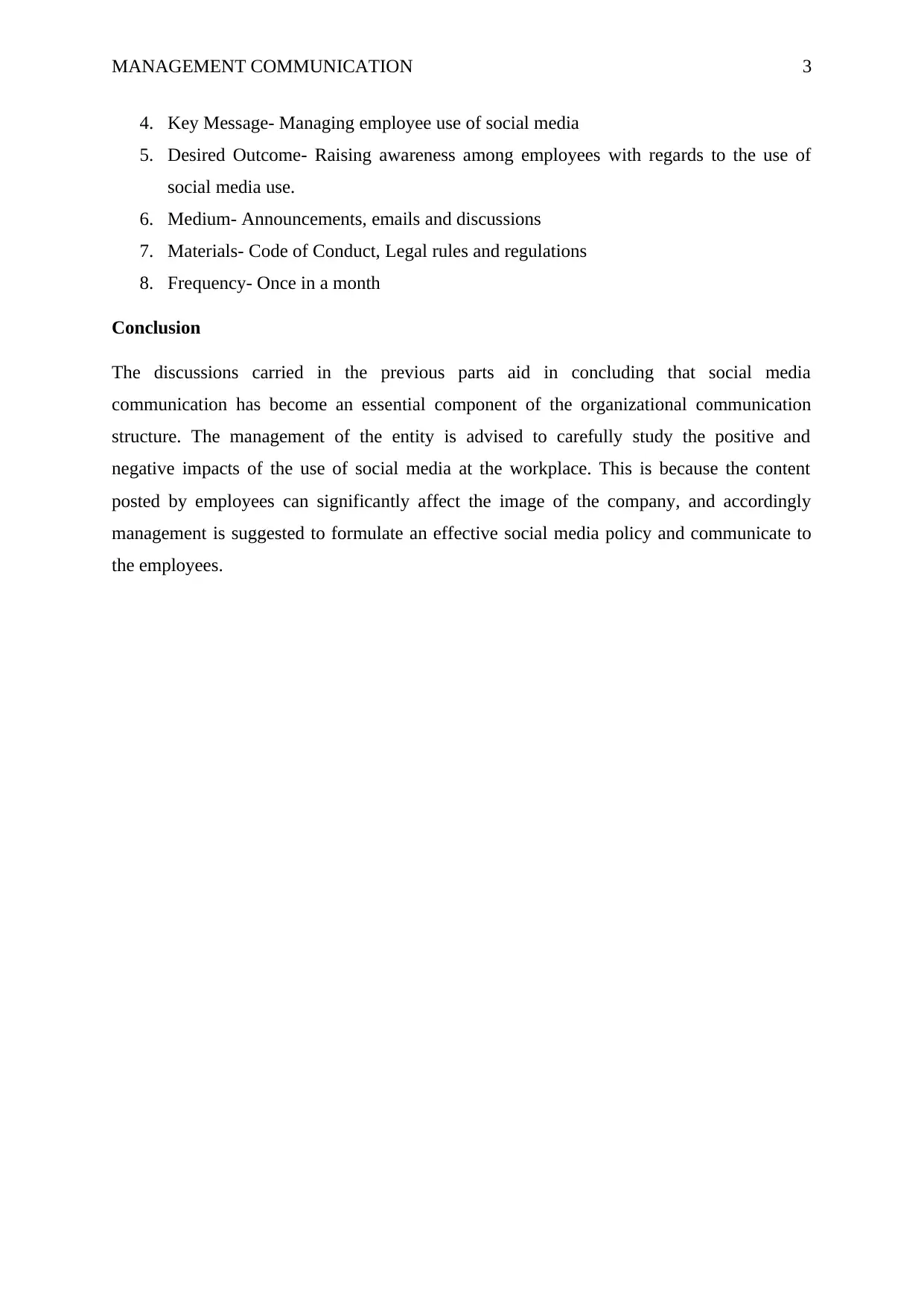
MANAGEMENT COMMUNICATION 3
4. Key Message- Managing employee use of social media
5. Desired Outcome- Raising awareness among employees with regards to the use of
social media use.
6. Medium- Announcements, emails and discussions
7. Materials- Code of Conduct, Legal rules and regulations
8. Frequency- Once in a month
Conclusion
The discussions carried in the previous parts aid in concluding that social media
communication has become an essential component of the organizational communication
structure. The management of the entity is advised to carefully study the positive and
negative impacts of the use of social media at the workplace. This is because the content
posted by employees can significantly affect the image of the company, and accordingly
management is suggested to formulate an effective social media policy and communicate to
the employees.
4. Key Message- Managing employee use of social media
5. Desired Outcome- Raising awareness among employees with regards to the use of
social media use.
6. Medium- Announcements, emails and discussions
7. Materials- Code of Conduct, Legal rules and regulations
8. Frequency- Once in a month
Conclusion
The discussions carried in the previous parts aid in concluding that social media
communication has become an essential component of the organizational communication
structure. The management of the entity is advised to carefully study the positive and
negative impacts of the use of social media at the workplace. This is because the content
posted by employees can significantly affect the image of the company, and accordingly
management is suggested to formulate an effective social media policy and communicate to
the employees.
⊘ This is a preview!⊘
Do you want full access?
Subscribe today to unlock all pages.

Trusted by 1+ million students worldwide
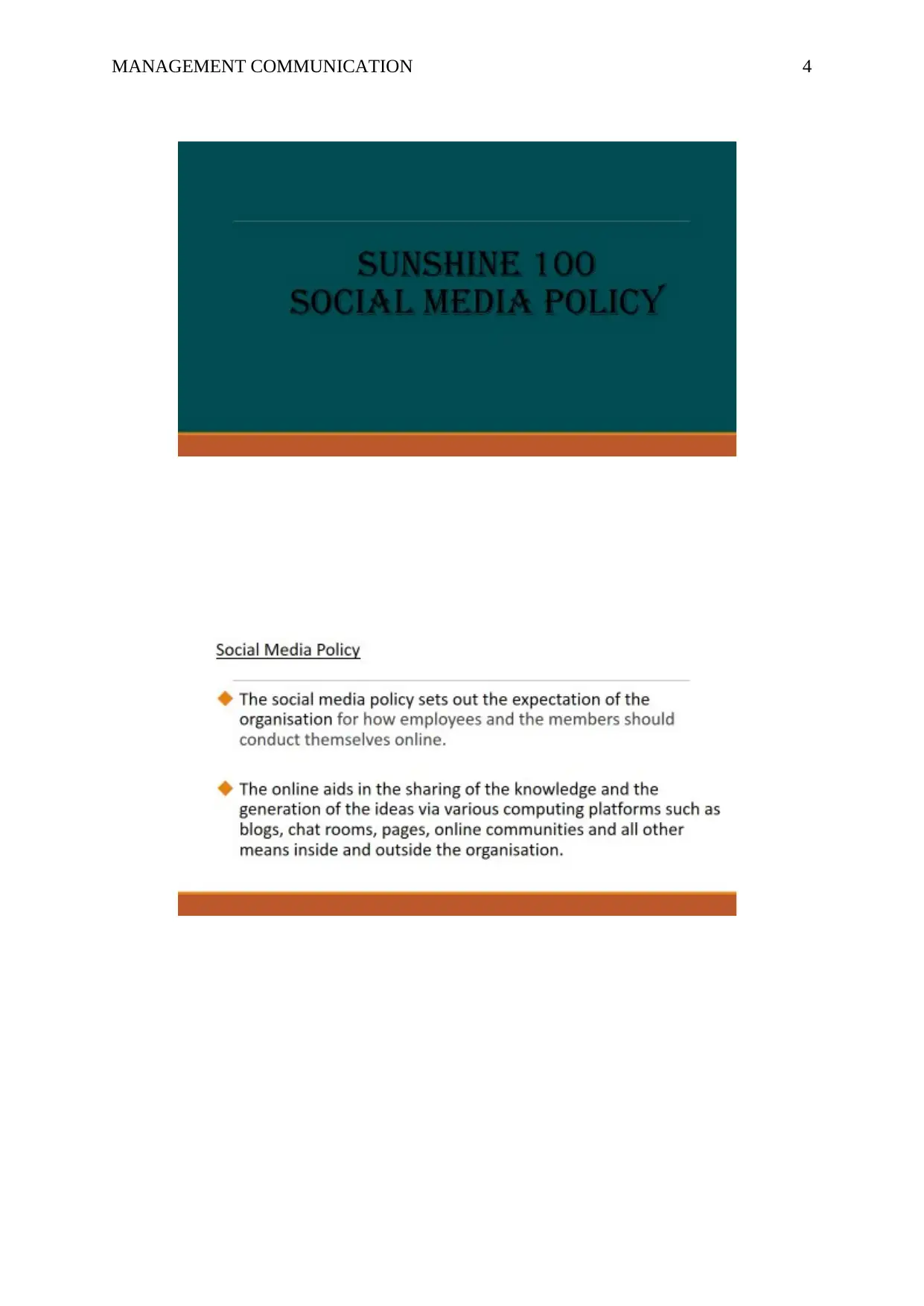
MANAGEMENT COMMUNICATION 4
Paraphrase This Document
Need a fresh take? Get an instant paraphrase of this document with our AI Paraphraser
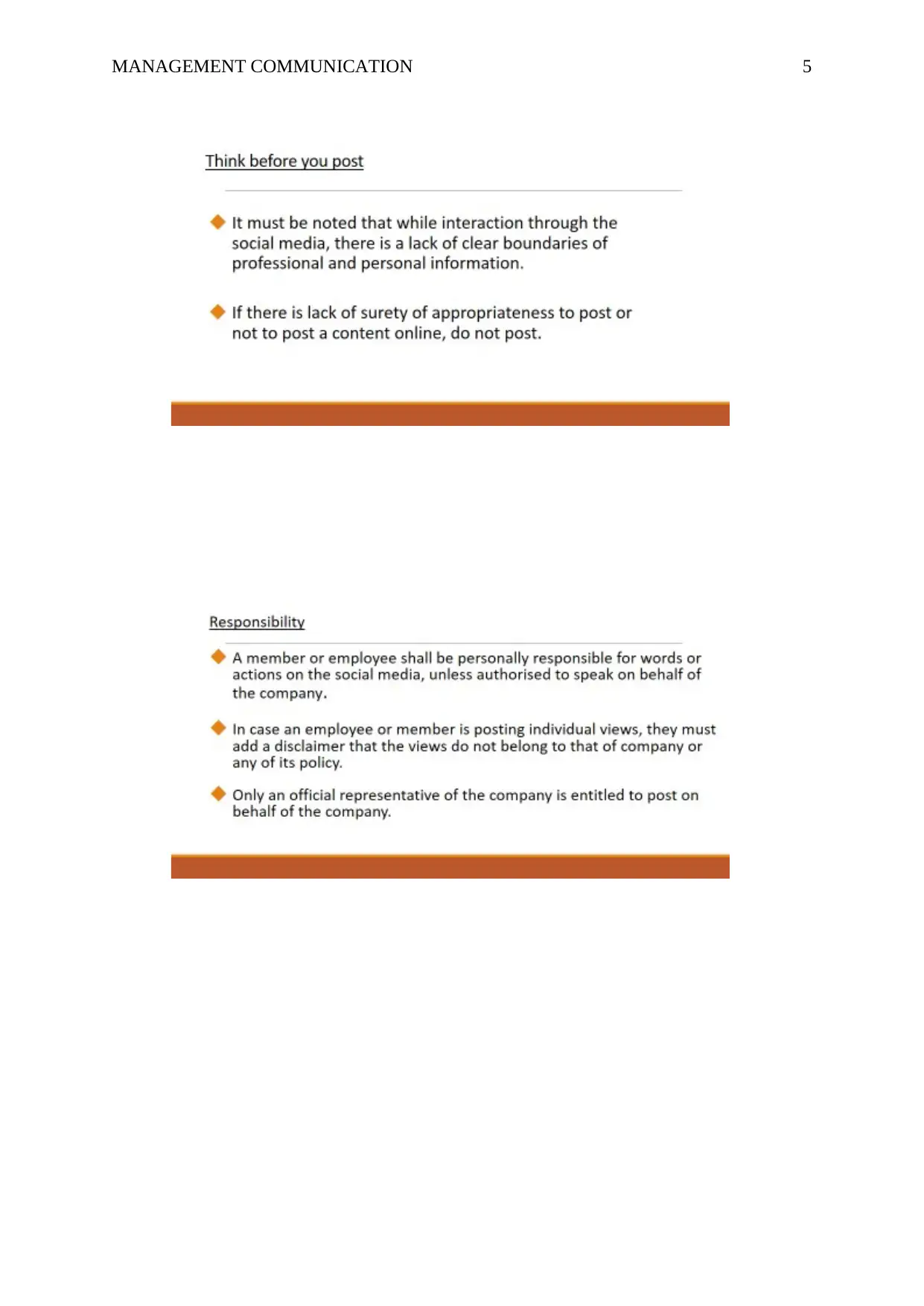
MANAGEMENT COMMUNICATION 5
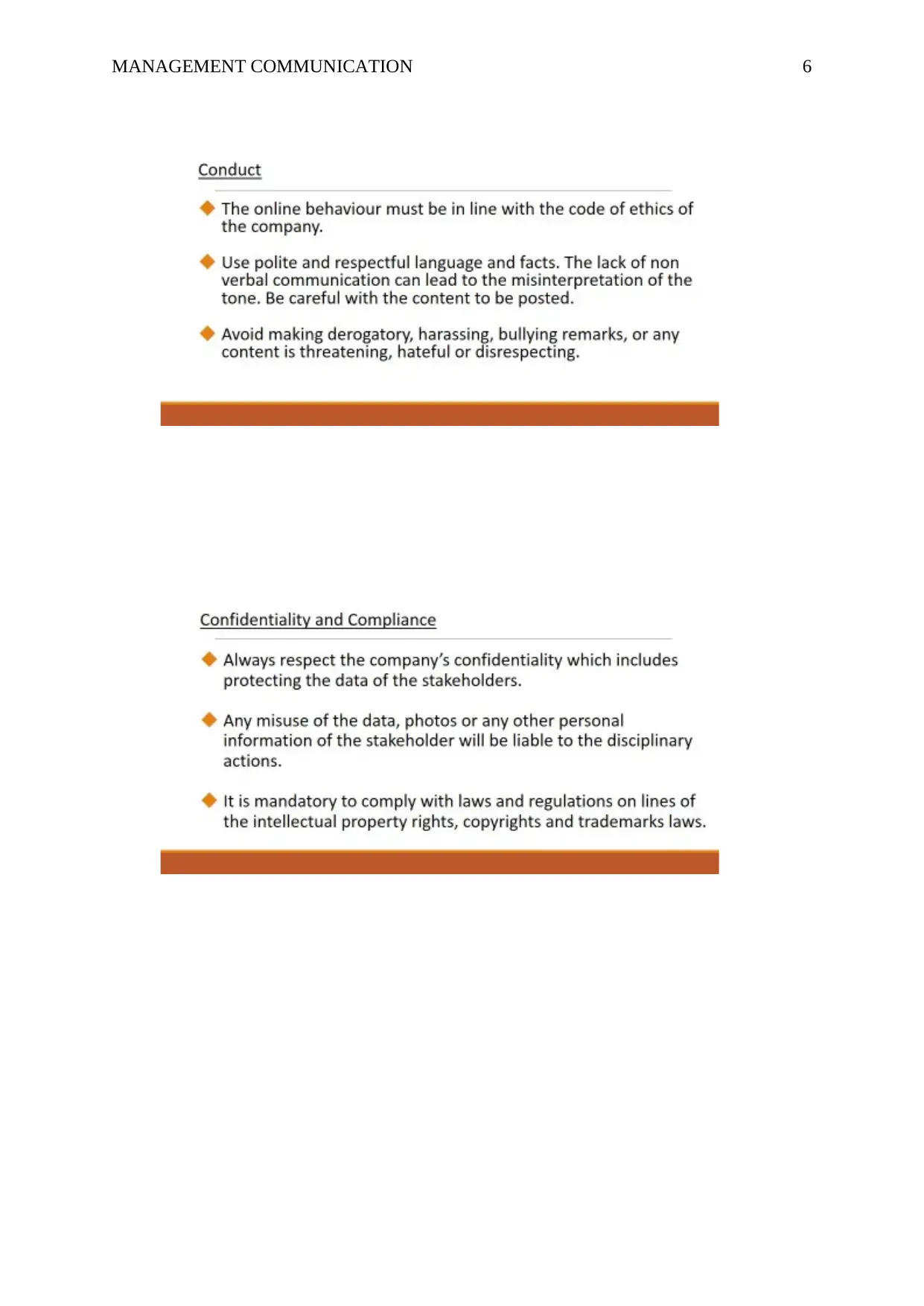
MANAGEMENT COMMUNICATION 6
⊘ This is a preview!⊘
Do you want full access?
Subscribe today to unlock all pages.

Trusted by 1+ million students worldwide
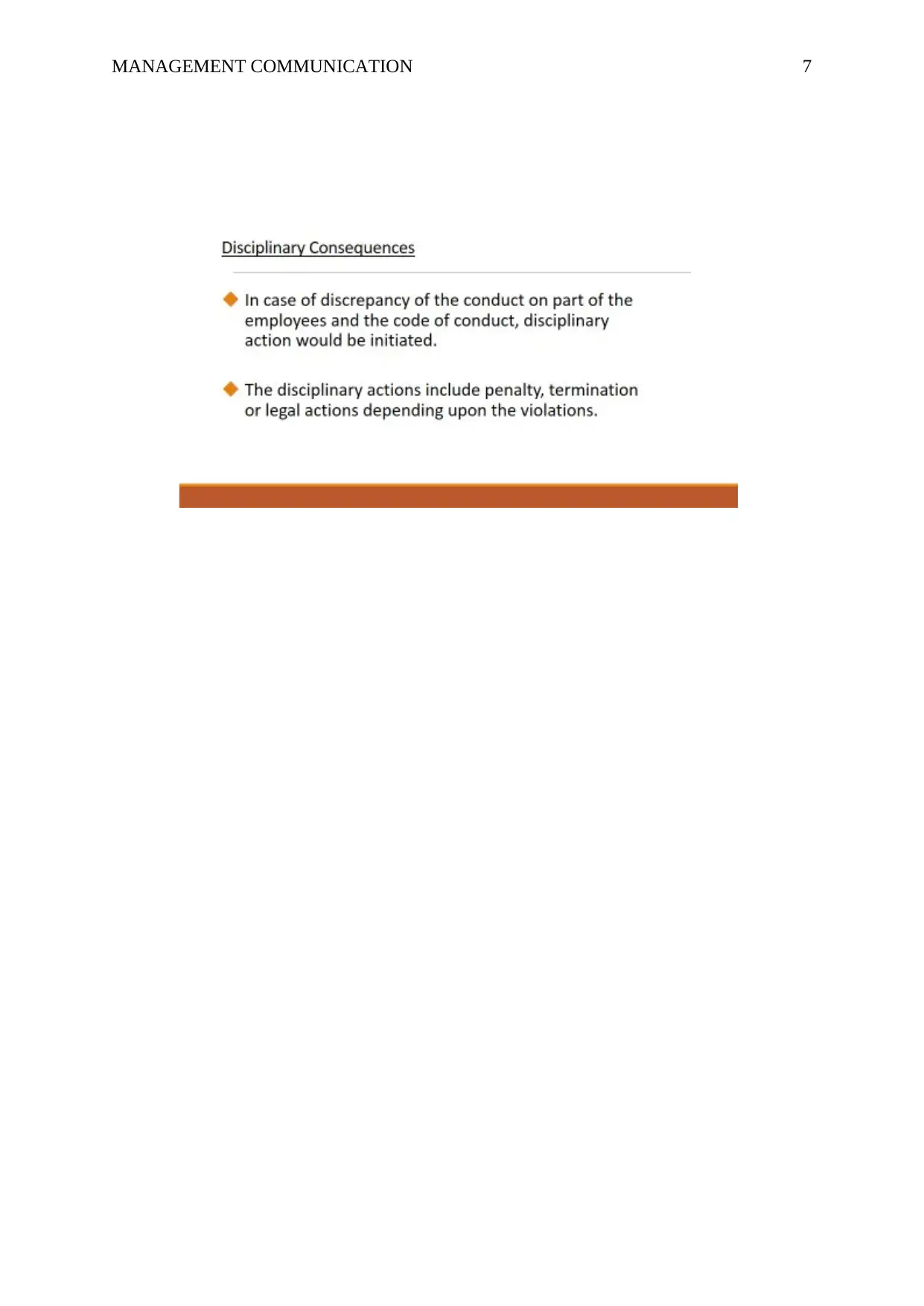
MANAGEMENT COMMUNICATION 7
Paraphrase This Document
Need a fresh take? Get an instant paraphrase of this document with our AI Paraphraser
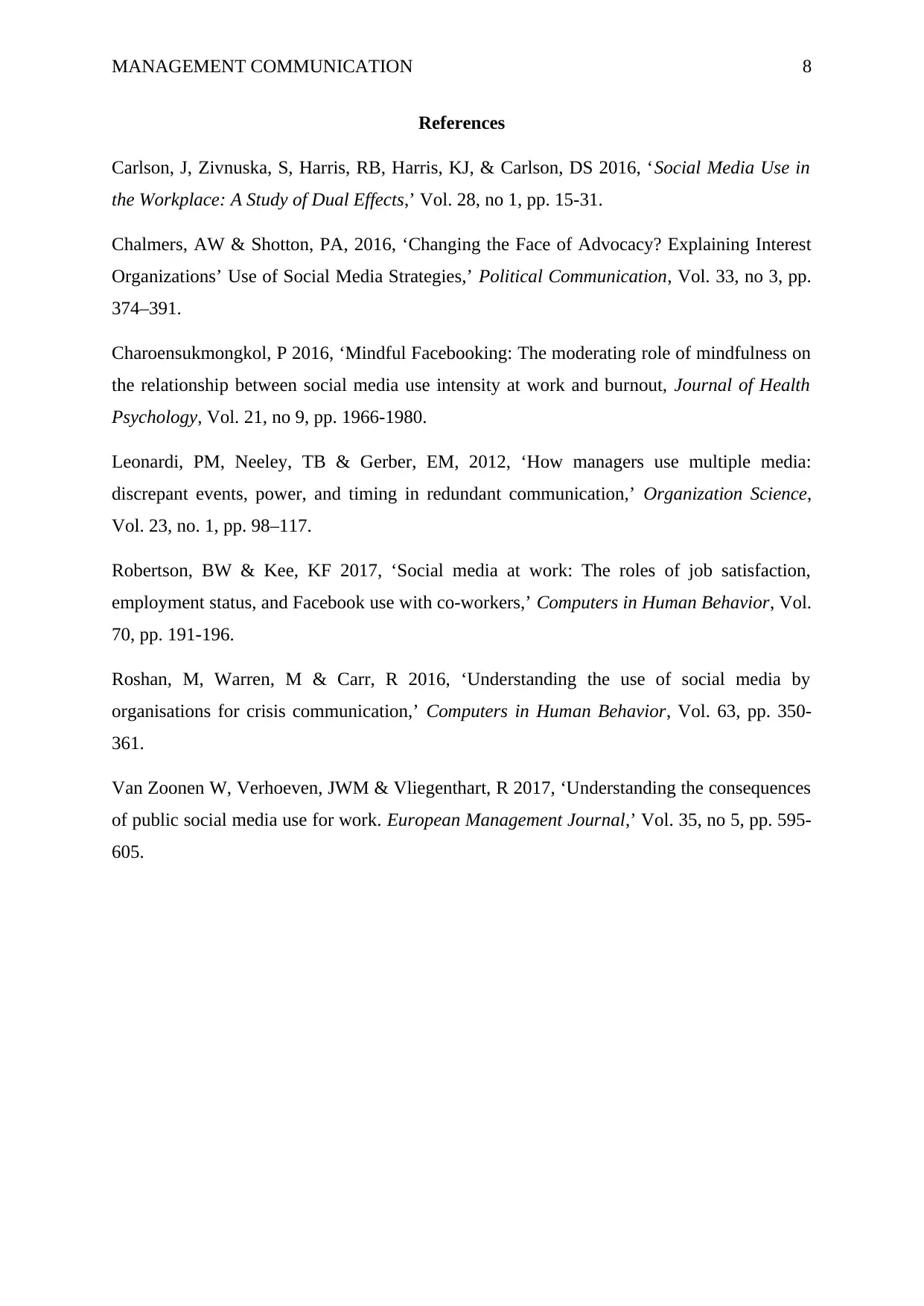
MANAGEMENT COMMUNICATION 8
References
Carlson, J, Zivnuska, S, Harris, RB, Harris, KJ, & Carlson, DS 2016, ‘Social Media Use in
the Workplace: A Study of Dual Effects,’ Vol. 28, no 1, pp. 15-31.
Chalmers, AW & Shotton, PA, 2016, ‘Changing the Face of Advocacy? Explaining Interest
Organizations’ Use of Social Media Strategies,’ Political Communication, Vol. 33, no 3, pp.
374–391.
Charoensukmongkol, P 2016, ‘Mindful Facebooking: The moderating role of mindfulness on
the relationship between social media use intensity at work and burnout, Journal of Health
Psychology, Vol. 21, no 9, pp. 1966-1980.
Leonardi, PM, Neeley, TB & Gerber, EM, 2012, ‘How managers use multiple media:
discrepant events, power, and timing in redundant communication,’ Organization Science,
Vol. 23, no. 1, pp. 98–117.
Robertson, BW & Kee, KF 2017, ‘Social media at work: The roles of job satisfaction,
employment status, and Facebook use with co-workers,’ Computers in Human Behavior, Vol.
70, pp. 191-196.
Roshan, M, Warren, M & Carr, R 2016, ‘Understanding the use of social media by
organisations for crisis communication,’ Computers in Human Behavior, Vol. 63, pp. 350-
361.
Van Zoonen W, Verhoeven, JWM & Vliegenthart, R 2017, ‘Understanding the consequences
of public social media use for work. European Management Journal,’ Vol. 35, no 5, pp. 595-
605.
References
Carlson, J, Zivnuska, S, Harris, RB, Harris, KJ, & Carlson, DS 2016, ‘Social Media Use in
the Workplace: A Study of Dual Effects,’ Vol. 28, no 1, pp. 15-31.
Chalmers, AW & Shotton, PA, 2016, ‘Changing the Face of Advocacy? Explaining Interest
Organizations’ Use of Social Media Strategies,’ Political Communication, Vol. 33, no 3, pp.
374–391.
Charoensukmongkol, P 2016, ‘Mindful Facebooking: The moderating role of mindfulness on
the relationship between social media use intensity at work and burnout, Journal of Health
Psychology, Vol. 21, no 9, pp. 1966-1980.
Leonardi, PM, Neeley, TB & Gerber, EM, 2012, ‘How managers use multiple media:
discrepant events, power, and timing in redundant communication,’ Organization Science,
Vol. 23, no. 1, pp. 98–117.
Robertson, BW & Kee, KF 2017, ‘Social media at work: The roles of job satisfaction,
employment status, and Facebook use with co-workers,’ Computers in Human Behavior, Vol.
70, pp. 191-196.
Roshan, M, Warren, M & Carr, R 2016, ‘Understanding the use of social media by
organisations for crisis communication,’ Computers in Human Behavior, Vol. 63, pp. 350-
361.
Van Zoonen W, Verhoeven, JWM & Vliegenthart, R 2017, ‘Understanding the consequences
of public social media use for work. European Management Journal,’ Vol. 35, no 5, pp. 595-
605.
1 out of 8
Related Documents
Your All-in-One AI-Powered Toolkit for Academic Success.
+13062052269
info@desklib.com
Available 24*7 on WhatsApp / Email
![[object Object]](/_next/static/media/star-bottom.7253800d.svg)
Unlock your academic potential
Copyright © 2020–2025 A2Z Services. All Rights Reserved. Developed and managed by ZUCOL.





